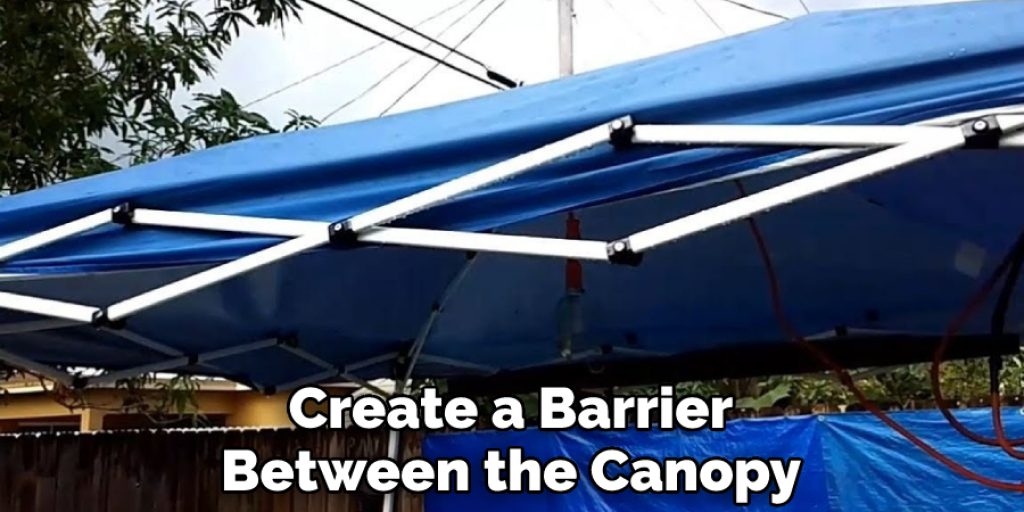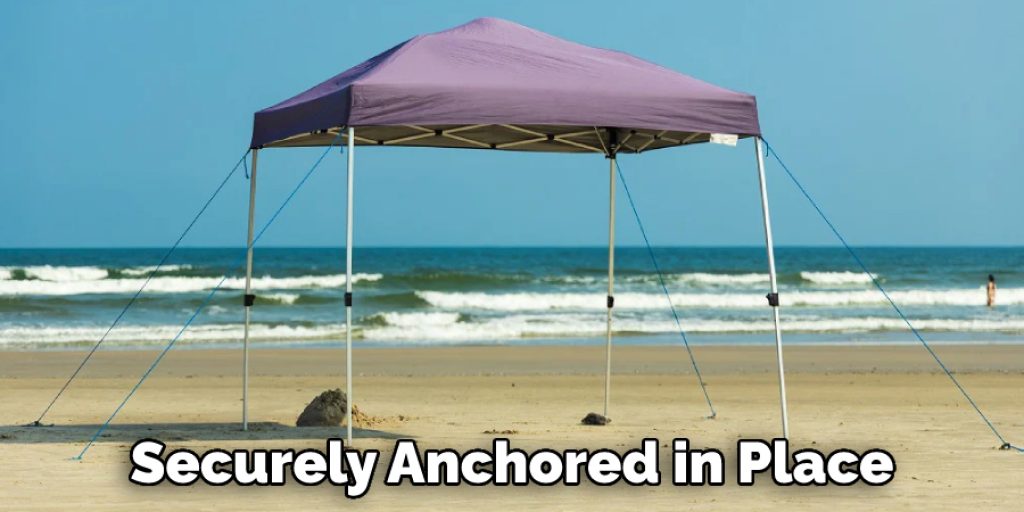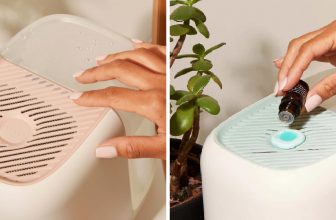How to Keep Water from Pooling on Canopy
Are you struggling with standing water on your canopy? Have pooling pools of water been ruining the aesthetic of your outdoor space and leaving behind unsightly puddles? If so, then this article is for you! Here we’ll discuss how to keep water from pooling on canopy. We’ll examine common problem areas, provide effective solutions that prevent rain and snow build-up, and suggest ways to help maintain once set-up measures are in place. Make sure to read through until the end to ensure maximum efficiency when it comes to keeping your canopy free from excess moisture!

What Can I Spray on My Canopy to Make It Waterproof?
Spraying your canopy with a sealant or waterproofing spray is one of the most effective ways to make it water-resistant. Make sure to pick up a product specifically designed for outdoor use and follow the instructions on the label carefully. Consider applying multiple coats for maximum protection against rain, snow, and other types of moisture. It’s also important to periodically reapply the sealant or waterproofing spray to keep your canopy in peak condition.
If you have a fabric canopy, there are also special treatments available to protect them from water damage. Fabric-specific waterproofing sprays typically contain ingredients that help make the material more water-resistant without compromising its breathability. When spraying a fabric canopy, make sure to test a small patch first to ensure it won’t cause discoloration or other issues. With proper care and maintenance, these sprays can help extend the life of your canopy significantly.
Finally, if you want maximum protection against water and moisture damage, you may want to consider investing in a genuine waterproof canopy. Many companies offer waterproof canopies that are designed to withstand the elements year-round. These can be pricier than their non-waterproof counterparts, but they will last much longer if you plan on using your canopy outdoors frequently and in areas with frequent rainfall.
10 Methods How to Keep Water from Pooling on Canopy
1. Use a Tarp
One of the simplest ways to keep water from pooling on your canopy is to use a tarp. Tarps are inexpensive and can be easily draped over your canopy to create a barrier between the canopy and the elements. Tarps are also lightweight and easy to store, making them a great option for those who need to take their canopy down frequently. If you are using a tarp, make sure it is large enough to cover the entire canopy and that the edges are securely in place.

2. Use Sandbags
If you live in an area that is prone to high winds, sandbags can be a great way to keep your canopy in place. Simply place the sandbags around the perimeter of your canopy and weigh them down with rocks or other heavy objects. The sandbags will act as anchors, keeping your canopy from blowing away in strong winds. You can also use them to keep the canopy from sagging in the middle, as this can cause water to pool. Make sure you place enough sandbags to cover the entire perimeter of your canopy.
3. Use Canopy Weights
Canopy weights are specifically designed to keep canopies in place during inclement weather. Canopy weights come in a variety of sizes and can be filled with water or sand to provide extra stability. Most canopy weights have handles or loops that make them easy to transport and set up.
They can be placed at the four corners of the canopy and help to hold it down so that water does not collect on top. Additionally, some canopy weights come with a stake that can be used to secure the weights in place. Canopy weights are essential for ensuring that your canopy stays in place during windy and wet weather.
4. Use Guy Lines
Guy lines are lengths of rope or cord that are attached to the corners of a canopy and staked into the ground. Guy lines help to keep canopies from blowing away in high winds and also prevent them from collapsing under the weight of heavy rain or snow. When setting up your canopy, be sure to use high-quality guy lines that are rated for inclement weather conditions. Additionally, check the lines periodically to make sure that they are still taut.

5. Use a Canopy Cover
A canopy cover is a piece of fabric that is designed to fit over your existing canopy. Canopy covers are typically made from waterproof or water-resistant materials and can provide an extra layer of protection from the elements. Most canopy covers are available in a variety of sizes to accommodate different types of canopies.
When selecting a canopy cover, make sure it fits your canopy tightly to prevent water from pooling on top. Additionally, look for a canopy cover that is easy to install and remove so that you can adjust it according to the weather.
6. Seal Your Canopy
If you have an older canopy that is not waterproof, you can try sealing it with a waterproofing spray or sealant. There are a variety of products on the market that can be used to waterproof canopies, so be sure to read the labels carefully before making your purchase.
It is also important to note that sealed canopies should be re-sealed on a regular basis to maintain their waterproofing properties. Additionally, sealed canopies should not be placed in areas where there is direct sunlight, as it can cause the sealant to break down over time.
7. Use a Canopy Extension
Canopy extensions are metal poles that can be attached to the top of your canopy to increase its height and help prevent water from pooling on it. Canopy extensions come in different sizes, so you should be able to find one that fits your needs. However, keep in mind that adding an extension may reduce the amount of headroom you have under the canopy.

Make sure you measure the space before buying an extension. When you have the right size, simply attach it to your canopy and enjoy the improved drainage around your canopy.
8. Install Gutter Extensions
Gutter extensions are small pieces of plastic or metal that attach to the sides of your canopy and direct rainwater away from it. Gutter extensions are relatively inexpensive and easy to install and can provide a great way to keep water off your canopy during storms or heavy rains. Make sure to clean the gutters regularly and clear any debris that may be clogging up the system.
Additionally, check for any cracks or signs of rusting in the gutters and try to replace any older or damaged parts as soon as possible. With proper maintenance, gutter extensions can be an effective way to keep water from pooling on the canopy.
9. Use a Deck Awning
Deck awnings are metal or canvas structures that can be attached to the side of your house to provide additional protection from the elements. If you have space on your deck, installing an awning is a great way to keep water from pooling on your canopy during storms. Be sure to check local building codes for any required permits.
Additionally, make sure you choose an awning that is large enough to cover your canopy. This will ensure that no additional water pools on your canopy during heavy rain or snow. Additionally, deck awnings require little to no maintenance and will last for years.
10. Build Your Canopy Higher
If you have the means and resources available, it may be wise to build your canopy higher off the ground. This will allow more room for rainwater to run off and reduce the risk of water pooling on top of it during severe weather conditions. Keep in mind that if you do choose to raise your canopy, you will also need to make sure that it is securely anchored in place to avoid any accidents or injuries.

Using any combination of the above methods, you can ensure that your canopy stays dry and safe during inclement weather conditions. Keep in mind that even with all the necessary precautions, some water may still accumulate on the canopy during heavy rains or storms. In this case, it is important to check your canopy regularly for any signs of wear and tear and make sure that all safety measures are in place. With the right preparation, you can make sure that your canopy remains safe and dry during any kind of weather.
Conclusion
If you have a canopy over your patio, keeping water from pooling on it is important for both the stability of the structure and to prevent any accidental falls or injuries. While there are many ways to achieve this, we think the most effective option is to use a bristle brush attachment on your vacuum cleaner.
By brushing away debris and leaves regularly, you can help ensure that water has nowhere to collect and pool. We hope this guide on how to keep water from pooling on canopy was helpful. Please share it with your friends on social media if you find it useful. And be sure to check back here soon for more informative guides like this one.
You Can Check It Out to Fix Sagging Canopy




